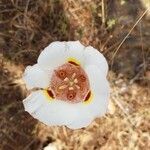Plants bulbose; bulb coat membranous. Stems usually branching, 1–6 dm. Leaves: basal withering, 1–2 dm; blade linear. Inflorescences subumbellate, 1–6(–10)-flowered; bracts 2–8 cm. Flowers erect; perianth open, campanulate; sepals lanceolate, 3–5 cm, apex recurved; petals white to brightly or deeply yellow, purple, or dark red, with dark red median blotch, often with second paler distal blotch, obovate or cuneate to clawed, rounded, 3–5 cm, with scattered proximal hairs, apex retuse to obtuse; glands in lower middle of petal, ± square, sometimes ovate, not depressed, covered with short, orange to red-purple hairs; filaments usually equaling anthers; anthers linear-lanceolate to oblong. Capsules erect, linear, angled, 5–6 cm. Seeds light beige, ± flat, 4–6 mm. 2n = 14.
More
A bulb plant. It grows 20-60 cm high and 8-10 cm wide. The leaves are oval to sword shaped. The flowers are cup-shaped. There can be 3 per stem. The flowers are erect on stems 60 cm long. They vary from white to yellow to red. There is a dark red blotch at the centre of the inner petals ringed with yellow. The flowers are 2.5-5 cm long.

